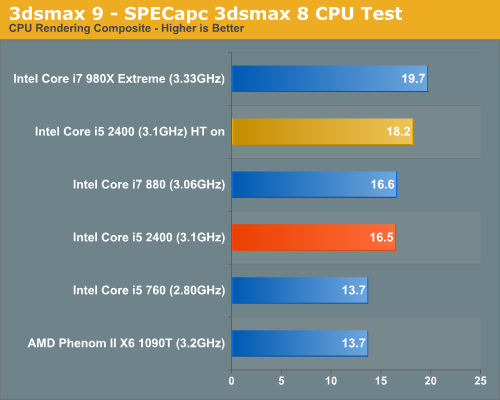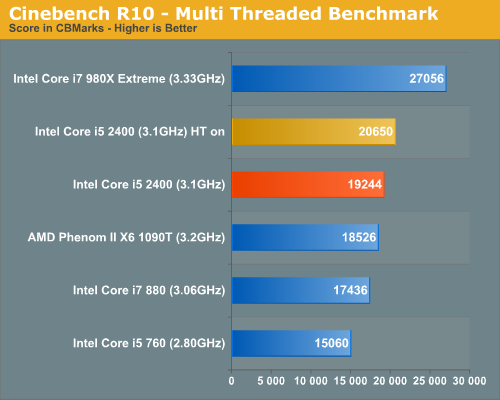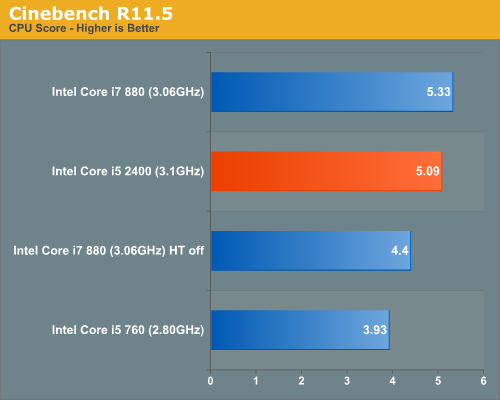The Sandy Bridge Preview
by Anand Lal Shimpi on August 27, 2010 2:38 PM EST3dsmax 9 - SPECapc 3dsmax CPU Rendering Test
Today's desktop processors are more than fast enough to do professional level 3D rendering at home. To look at performance under 3dsmax we ran the SPECapc 3dsmax 8 benchmark (only the CPU rendering tests) under 3dsmax 9 SP1. The results reported are the rendering composite scores:

This is another one of those situations where the Core i5 2400 without Hyper Threading is able to perform on par with the Core i7 880 with Hyper Threading. Compared to the i5 760 it’s 20.5% faster.
With Hyper Threading enabled, the Core i5 2400 is actually dangerously close to the 6-core 980X. Whatever Intel has done to Sandy Bridge's FP is big.
Cinebench R10
Created by the Cinema 4D folks we have Cinebench, a popular 3D rendering benchmark that gives us both single and multi-threaded 3D rendering results.

Cinebench was particularly surprising because it gives us a good opportunity to look at single threaded FP performance. Compared to a similarly clocked Lynnfield, Sandy Bridge can deliver 11% better performance. Compared to a similarly positioned Lynnfield, Sandy Bridge is about 20% faster. Note that this is without turbo enabled. The retail 3.1GHz chip should turbo up to 3.4GHz in this test, giving it a 9.6% frequency boost.
In the multithreaded test Sandy Bridge’s per-core performance is even better than Lynnfield with HT enabled.

I also ran a few numbers using Cinebench R11.5. I didn’t have the opportunity to test the i5 2400 with HT enabled in this test so I measured performance of the i7 880 with HT enabled/disabled to compare per-thread performance.

Sandy Bridge's FP performance is very good. Clock for clock we see a 15.6% improvement over Lynnfield (4C/4T vs. 4C/4T). Compared to the proposed similarly priced Core i5 760, the i5 2400 would be 29.5% faster.
POV-Ray 3.73 beta 23 Ray Tracing Performance
POV-Ray is a popular, open-source raytracing application that also doubles as a great tool to measure CPU floating point performance.
I ran the SMP benchmark in beta 23 of POV-Ray 3.73. The numbers reported are the final score in pixels per second.

The similarly positioned/priced Core i5 760 is beat by 17%. There’s no replacement for more cores/threads however as the i7 880 and X6 parts both pull ahead. Turn on HT to level the playfield (at least within Intel) and Sandy Bridge is 15% faster than Lynnfield.










200 Comments
View All Comments
wut - Sunday, August 29, 2010 - link
Yep. I bet AMD is really wondering about that right now.greenguy - Saturday, August 28, 2010 - link
I bought basically what is an i5-750 based on Anand's review here. Or at least, the Xeon version with hyperthreading (needed ECC RAM).From what I can tell, you get about a 20%-30% improvement over the i5-750, with the same power consumption. That's pretty good. Not only that, you get some competent entry level graphics... which would have good open source drivers. That's somewhat exciting, though I wonder whether it would do multiple monitors. Any idea on that Anand?
Maybe I'll just stick to the cheapest Nvidia discrete cards I can buy, a couple G210s do the trick (to get 4 1920x1200 monitors). Unless Intel can make those G210s redundant, it represents just an incremental bump in performance, as the only thing that is of interest is the increase in CPU. One thing that is nice is that Intel is reputed to have the best open source support for their GPU drivers, which makes things really interesting now they are producing stuff that will compete with the entry level discrete market. It could be really good for Linux/BSD people like myself.
The other thing of interest for me is in the low power, low cost, high numbers of SATA connections space, with ECC. I wonder if Bobcat will have something there, as AMD don't seek to arbitrarily differentiate their markets like Intel does with the ECC RAM.
Also not really sure what the big thing is with the motherboards and same CPU. I tend to keep the same computer as a build. By the time you want to upgrade the CPU, there is invariably other stuff that needs upgrading, e.g. USB3, graphics, SATA, RAM, whatever. So you end up wasting the old parts for not that much benefit. Better to just re-purpose the old machine, and when you have enough money, buy the most performant parts that are still good bang for buck. A good example was the i5-750 about 8 months ago or so. So I don't fault Intel for this.
wut - Sunday, August 29, 2010 - link
Intel's going after the mid range market, where most of the money is. We'll have to wait and see how good AMD's Fusion mid range ends up being. Even if it catches up all the way and achieves performance parity so AMD can make more money by raising prices, Intel would have their newest gen on the market first. Fusion had better be really, really, good...Hrel - Sunday, August 29, 2010 - link
I'd say if that 2500K is 215 or less it'd be a fair buy. I'd still wait for the price to drop below 200 cause that's my absolute cap on a CPU. I am a little annoyed that it doesn't have hyper threading though, from a moral standpoint, I mean, from a raw material standpoint how much does adding hyperthreading cost? nothing! yeah, that's what I thought.Hrel - Sunday, August 29, 2010 - link
Those are some impressive integrated graphics. I've thought this for a while now, but we really don't need a card any lower than the HD5670, and maybe the 5650 in discrete graphics. Prefferably just the 5670 though. If mobo makers start setting aside a single DDR3 slot for the integrated GPU to use and dedicated GPU only memory, like a discrete GPU, so the integrated GPU doesn't have to share system RAM we really won't need low end graphics in laptops at all anymore.mino - Sunday, August 29, 2010 - link
Adequate.5450 is the LOWEST END card from 2008, A facelifted 4350.
And 780G, it FINALLY manages to out-pace, in 2011, is the mainstream part of 2008 too.
In 2011 there will be a 10W Ontario with 5450-class GPU on 40nm bulk ...
On the other hand it seems Intel is thaking the GPU side seriously. Finally.
But they are still where ATI/NV were in 2004 ...
LuckyKnight - Sunday, August 29, 2010 - link
I would have liked to have seen a better comparison when it comes to idle power consumption? How much has it improved since moving to a 45nm->32nm GPU?Also, has Intel addressed the Clarkdale issue of not outputting industry standard 24fps? (23.976 hz)
Miggleness - Sunday, August 29, 2010 - link
I was planning on purchasing an i5-760 in 2 weeks but looks like I'll have to settle for 2nd hand, low end parts instead and wait for the i5-2400's release.Great job Intel. I for one no longer have that much interest in overclocking when I have Turbo boost to compensate for that.
Hope we hear about the official pricing soon.
jfelano - Sunday, August 29, 2010 - link
Intel could have hit one out of the park with this one if it worked on existing s1155 motherboards....unfortunately it doesn't and it screws over everyone who bought into s1156 or s1366.....yet again.siberian 3 - Sunday, August 29, 2010 - link
Hi everyone i've read the preview and i am not so impresed by the performance of SB.The IGPis great but it make sense only for the mobile section of the pc not the desktop!!
From the preview i understand that this is not a real fusion product but an evolution off clarkdale and arandale products.
So i will wait for Llano to see what Amd has to offer!!!